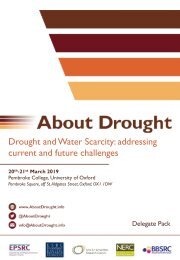About Drought Handbook: Outputs & Impacts
As the UK’s £12m Drought and Water Scarcity (DWS) research programme reaches its conclusion with a final event at The Royal Society in London, this handbook draws together the key outputs and outcomes. The book also features a series of interviews with our leading stakeholders, which highlight how successfully we have met our objectives to produce cutting-edge science that has made a demonstrable impact on how decision-makers manage water scarcity in the UK.
As the UK’s £12m Drought and Water Scarcity (DWS) research programme reaches its conclusion with a final event at The Royal Society in London, this handbook draws together the key outputs and outcomes. The book also features a series of interviews with our leading stakeholders, which highlight how successfully we have met our objectives to produce cutting-edge science that has made a demonstrable impact on how decision-makers manage water scarcity in the UK.
- No tags were found...
Create successful ePaper yourself
Turn your PDF publications into a flip-book with our unique Google optimized e-Paper software.
DRY:<br />
PUBLICATIONS<br />
Shepherd T. et. al., (2018) Storylines: an alternative approach<br />
to representing uncertainty in physical aspects of climate<br />
change. Climatic Change.<br />
http://dx.doi.org/10.1007/s10584-018-2317-9<br />
Smith K. et. al., (2018) Navigating Cascades of Uncertainty<br />
- As Easy as ABC? Not Quite. Journal of Extreme Events.<br />
http://dx.doi.org/10.1142/S2345737618500070<br />
Smith K. et. al., (2019) A Multi-Objective Ensemble Approach<br />
to Hydrological Modelling in the UK: An Application to<br />
Historic <strong>Drought</strong> Reconstruction. Hydrology and Earth<br />
System Sciences.<br />
https://doi.org/10.5194/hess-23-3247-2019<br />
Tanguy M. et. al., (2018) Historical gridded reconstruction<br />
of potential evapotranspiration for the UK. Earth System<br />
Science Data.<br />
http://dx.doi.org/10.5194/essd-10-951-2018<br />
Woollings T. et. al., (2018) Daily to Decadal Modulation of Jet<br />
Variability. Journal of Climate.<br />
http://dx.doi.org/10.1175/JCLI-D-17-0286.1<br />
DRY publications cont...<br />
Journal Articles<br />
Afzal, M. et. al., (2019) <strong>Drought</strong> risk under climate and land<br />
use changes: implication to water resource availability at<br />
catchment scale. Water, 11 (9), 1790. 29, pp.<br />
https://doi.org/10.3390/w11091790<br />
Roberts, E. et. al., (2017) Narratives as a mode of research<br />
evaluation in citizen science: Understanding broader science<br />
communication impacts. Journal of Science Communication.<br />
https://jcom.sissa.it/archive/16/04/JCOM_1604_2017_A03<br />
Wilson M., (2017) ‘Some Thoughts on Storytelling, Science<br />
and Dealing with a Post-Truth World’. Storytelling, Self and<br />
Society. https://bit.ly/2odIRIW<br />
Performance<br />
There’s Something in the Water https://bit.ly/2ny8Zyj<br />
Think Water: Storytelling for the future of Peterborough<br />
and the Fens https://youtu.be/c4l1KlDZaek<br />
Monograph<br />
Garde-Hansen, J., Remembering and Re-mediating Women<br />
in <strong>Drought</strong>. Media and Water: Communication, Culture and<br />
Perception I.<br />
Book Chapters<br />
Bakewell, L., et. al. From Gallura to the Fens: Communities<br />
Performing Stories of Water. In: Roberts, L, et. al. (eds.) Water,<br />
Creativity and Meaning: Multidisciplinary understandings of<br />
human-water relationships.<br />
Film/Video/Animation/Podcasts<br />
DRY Digital Stories<br />
http://dryproject.co.uk/resources/digital-narratives/<br />
Stories <strong>About</strong> <strong>Drought</strong>: Quinoa vs. Potato<br />
http://www.vimeo.com/224749603<br />
Improvements to Research Infrastructure<br />
The Reasons: a new, performative methodology, based on<br />
traditional practices. https://bit.ly/2nxsiaO<br />
Research reports, summaries and guidance<br />
Blake, J.R. et. al., (2014) <strong>Drought</strong> Risk and You (DRY):<br />
Case Study Catchments – Physical Characteristics and<br />
Functioning, Work Package 3 Deliverable, CEH, Wallingford.<br />
Grove, I. et. al., (2018) NERC DRY project Report and<br />
Results from HAU Agricultural Mesocosms. Unpublished<br />
report. 114pp. dryutility.info<br />
Weitkamp, E., et. al., (in press) Reaching Publics: Tailoring and<br />
Targeting <strong>Drought</strong> Risk Communication (Insights from the<br />
DRY project) http://dryutility.info/guidance/<br />
Weitkamp, E et. al., (in press) “Communicating the hidden”:<br />
drought risk, water shortage and communities.<br />
http://dryutility.info/guidance/<br />
Webtools<br />
Archive of drought narrative resources for seven catchments<br />
http://www.dryproject.co.uk<br />
Flood Memory App https://flappy.warwick.ac.uk<br />
Examples of thought pieces:<br />
Below are examples of thought pieces available on the DRY<br />
website:<br />
Blake, J.R. (2015) ‘<strong>Drought</strong> means different things to<br />
different people’, https://bit.ly/2ojHB71<br />
Garde-Hansen, J. (2017) ‘Animating <strong>Drought</strong>: Making<br />
the invisible visible through a persistence of vision’,<br />
https://bit.ly/2nuaa1F<br />
Morris J (2017) Liberalisation of the water industry<br />
https://bit.ly/2nkx37T Examples of thought pieces:<br />
55




